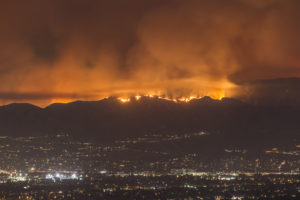
Two of the three largest fires in California's history are burning in the San Francisco Bay Area. Wildfires have burned a record 2 million acres in California this year, and the danger for more destruction is so high the U.S. Forest Service announced Monday it was closing all eight national forests in the southern half of the state, according to InsuranceJournal.com.
Randy Moore, Regional Forester for the Forest Service’s Pacific Southwest Region that covers California, announced the closures and added that the decision would be re-evaluated daily. Campgrounds at all national forests in the state also were closed.
“The wildfire situation throughout California is dangerous and must be taken seriously.” Moore told the news outlet. “Existing fires are displaying extreme fire behavior, new fire starts are likely, weather conditions are worsening, and we simply do not have enough resources to fully fight and contain every fire.”
Lynne Tolmachoff, spokeswoman for the California Department of Forestry and Fire Protection, or Cal Fire, said it’s “unnerving” to have reached a record for acreage burned when September and October usually are the worst for fires because vegetation has dried out and high winds are more common. (The previous high was 1.96 million acres burned in 2018. Cal Fire began tracking the numbers in 1987, she said).
"While the two expansive Bay Area fires were largely contained after burning for three weeks, firefighters struggled to corral several other major blazes ahead of the expected winds. Evacuation orders were expanded to more mountain communities Monday as the largest blaze, the Creek Fire, churned through the Sierra National Forest in Central California," InsuranceJournal reported.
California is not the only state threatened by the chance of raging wildfires
Behind California, Texas, Colorado, Arizona, Idaho, Washington, Oklahoma, Oregon, Montana, and Utah also are at increasing risk, according to a recent analysis of FEMA data by QuoteWizard.com.
“Data shows that the frequency of wildfires has increased exponentially since 1980,” the site reported. “This uptick is especially noticeable in Texas and California, where a many of the country's wildfires take place.”
Over the past four decades, the study found that Colorado, Nevada and New Mexico “saw the largest increase in natural disasters with wildfires being the primary cause” and estimated wildfire-related property loss at $485 billion.
In addition, it found that more than four million properties are at risk of wildfire damage and destruction in the aforementioned top-ten wildfire-prone states.
According to the National Interagency Fire Center, there were 58,083 wildfires in 2018 that burned 8.8 million acres of land. By comparison, 2019 had 50,477 wildfires that destroyed 4.7 million acres. Figures were lower in 2019, but, reported QuoteWizard, “that means little for anyone who is part of that statistic.”
Those numbers lead to California having an average home insurance rate of $1,684, well above the national home insurance average rate of $1,215.
What typical insurance covers when it comes to fire
Homeowners generally can expect to be insured under their home insurance in case of wildfire damage, but, reported QuoteWizard, “there are exceptions and limits.”
“In the event of a covered fire, home insurance should take care of the structure of the home, belongings, relocation costs if necessary and other issues associated with fire,” the site reported. They added that homeowners in these high-risk areas, like California, might see higher premiums.
The report went on to outline how insurance typically works as it relates to fire.
Home insurance covers the home from sudden and accidental fire, they said. This also includes damage due to smoke; The personal property coverage section of standard homeowners insurance covers belongings. Most standard homeowners insurance policies have a personal property payout limit of 50%. Home insurance should also cover structures detached from the home, such as garages, gazebos and fences, usually at 10%. If a wildfire can causes homeowner to relocate while the home is repaired. Loss of use coverage, also called additional living expense coverage, helps to take care of relocation costs. Some home insurers offer debris removal coverage as part of standard home insurance. This coverage is usually between 5% and 10%.
Fire coverage isn't required by state law, but mortgage companies and other lenders can require it. The need becomes greater in a state that has a high risk for fire.
What it means for lenders
Piling onto the actual property damage often is a financial loss that results in decreased ability of borrowers to repay loans on time. Data from CoreLogic has shown “natural disasters cause a spike in mortgage delinquencies, which suggests [wildfires] will add to the economic hardship families are already experiencing during the pandemic.”
San Francisco, Denver, Los Angeles, and Houston are among the high-risk-of-wildfire cities who already have high delinquency rates, according to CoreLogic’s most recent Loan Performance Index.
Some extra help is available
GSE Fannie Mae recently reminded those impacted by the California wildfires and other natural disasters that mortgage assistance and disaster relief options are available.
Under Fannie Mae's guidelines for single-family mortgages impacted by a natural disaster, homeowners may request mortgage assistance by contacting their mortgage servicer following a disaster.
Mortgage servicers are authorized to suspend or reduce a homeowner's mortgage payments for up to 90 days – even without establishing contact – if the servicer believes the homeowner was affected.
Learn more about how to mitigate the impact of natural disaster at the Five Star Virtual Conference, which will include a panel discussing "The Impact of Natural Disasters on Servicing." Register here.

 DSNews The homepage of the servicing industry
DSNews The homepage of the servicing industry









